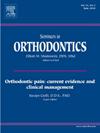Does 3D simulation impact clinical reasoning for orthodontic treatment planning of impacted maxillary canines?
IF 2.2
4区 医学
Q2 DENTISTRY, ORAL SURGERY & MEDICINE
引用次数: 0
Abstract
Clinical reasoning is an essential competence to develop in the diagnosis and treatment planning of impacted maxillary canines to ensure good treatment outcomes. It involves skills of radiographic interpretation and mental visualization. To master these, postgraduate students learn to interpret 2D and 3D X-rays to locate these canines accurately. This process demands the creation of mental models of the impaction and resolving it either by envisioning the canine's movement to its correct position or considering its removal. To facilitate this cognitive exercise, a 3D-printed simulator, derived from Cone Beam Computed Tomography scans, serves as a tool to allow students to experiment with various movement simulations, helping them select the most viable treatment approach.
This project aimed to assess the differences in expert and novice orthodontists’ clinical reasoning for impacted maxillary canines, and whether the addition of a 3D simulator would affect their reasoning. Thirteen (13) novices randomly assigned to a control and intervention group and three (3) experts took part in a Think-Aloud exercise to diagnose and treatment plan a case of bilaterally impacted maxillary canines. Experts and intervention group novices had the 3D simulator in addition to standardized patient records. Their responses were recorded and analyzed according to a coding scheme reflecting the clinical reasoning process. While experts demonstrated quick clinical judgment and found the 3D simulator redundant, novices were more uncertain and required additional cues. Novices using the 3D simulator described more elaborate treatment plans and had increased awareness of potential complications as compared to the control group.
三维模拟是否会影响上颌犬牙反颌正畸治疗计划的临床推理?
临床推理能力是上颌犬齿撞击的诊断和治疗计划中需要培养的一项基本能力,以确保良好的治疗效果。这涉及到X光片判读和心理可视化技能。为了掌握这些技能,研究生们要学习解读二维和三维 X 射线,以准确定位这些犬齿。这一过程要求建立阻生牙的心理模型,并通过设想将阻生牙移动到正确位置或考虑将其拔除来解决这一问题。为了促进这种认知练习,一个根据锥形束计算机断层扫描图像制作的 3D 打印模拟器可作为一种工具,让学生尝试各种运动模拟,帮助他们选择最可行的治疗方法。
本文章由计算机程序翻译,如有差异,请以英文原文为准。
求助全文
约1分钟内获得全文
求助全文
来源期刊

Seminars in Orthodontics
DENTISTRY, ORAL SURGERY & MEDICINE-
CiteScore
2.20
自引率
4.80%
发文量
28
审稿时长
10 days
期刊介绍:
Each issue provides up-to-date, state-of-the-art information on a single topic in orthodontics. Readers are kept abreast of the latest innovations, research findings, clinical applications and clinical methods. Collection of the issues will provide invaluable reference material for present and future review.
 求助内容:
求助内容: 应助结果提醒方式:
应助结果提醒方式:


